Indicator Review: Stay Seated on the Bull Train
Last week, I opined that there were two components to the recent stock market selloff; technical and fundamental. I suggested that the latter was tied to inflation, rates, and Fed expectations while the former had to do with computerized algorithmic trading and the blow-up of the short-vol trade. In closing last week's Monday morning market missive, I wrote that my takeaway from the week's action was that the technical picture had improved and that the bottom was likely in.
To clarify, this doesn't mean that the current rally will succeed or that stocks won't experience the traditional "retest" of the lows. However, it does appear that the bout of extreme volatility (as in 1,000 point moves back and forth on the DJIA) has run its course.
Where To From Here?
The question now, of course, is where do we go from here? Will Friday's surprise advance lead to more upside exploration this week? Or was the 350-point gain on the Dow merely a result of the blue-chip indices moving through their respective 50-day moving averages (yes, the algos definitely noticed where the 50-day was on Friday) and yields going the other way?
As long-time readers know, I don't like to make, nor manage money based on, "market calls" or my view of what "should" happen next in the markets. While I'm hardly devoid of opinions on the subject, my real focus is to attempt to stay in line with the major market cycles and the risk/reward environment at all times.
In short, instead of making a big market call, my goal is to "try and get it mostly right, most of the time." And if I have learned anything in my 30 years of managing money in the markets, it is that very few people can accomplish such a task by using their gut alone.
It is for this reason that I prefer a rules-guided approach to the markets. Sure, there is some discretion involved with my approach as I believe it would be silly to simply ignore one's experience gained in this game over the years. However, for me, the key is to listen to the message from my indicators and follow the weight of the evidence.
And this is why I publish what many probably view as a fairly mundane review of a bunch of indicators/models each Monday morning. It is the review of these "indicator boards" that guides my thinking on any decisions that need to be made during the week.
The Takeaway
So, my takeaway from this week's review of the indicators/models below is while an "all clear" signal has not been given, I believe the bulls should be given the benefit of the doubt here.
In short, my major market models designed to indicate the "state of the market" are mostly positive right now. My "State of the Tape" model is green. As are my "Desert Island," External Factors, Economic, and Inflation models.
Yes, it is true that the bulls aren't out of the woods yet. And that valuations as well as the action in the bond pits must be monitored. Oh, and the absolute levels of my favorite models aren't exactly robust here.
However, the bottom line is the models tell me the weight of the evidence leans bullish from a big-picture perspective.
Granted, this can change - and change quickly. But for now, the models say to remain seated on the bull train.
Thought For The Day:
Motivation gets you started. Habit keeps you going. -Jim Rohn
Wishing you green screens and all the best for a great day,

David D. Moenning
Founder, Chief Investment Officer
Heritage Capital Research
HCR Focuses on a Risk-Managed Approach to Investing
Must Read: What Risk Management Can and Cannot Do
HCR's Financial Advisor Services
HCR's Individual Investor Services
Questions, comments, or ideas? Contact Us
At the time of publication, Mr. Moenning held long positions in the following securities mentioned: None - Note that positions may change at any time.
The State of the Big-Picture Market Models
It's a new week, so let's start things off with a review of the state of my favorite big-picture market models, which are designed to tell us which team is in control of the prevailing major trend.
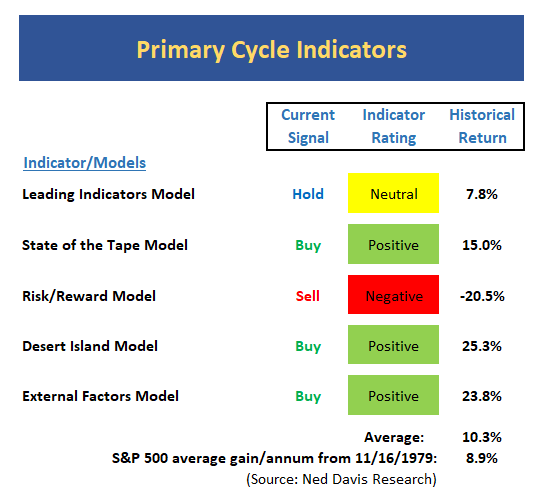
View My Favorite Market Models Online
Executive Summary:
- The Leading Indicators model, which is long-term oriented, remains on a long-term buy signal, but the indicator level pulled a bit more this week.
- Perhaps the most important change on any of the indicator boards over the past two weeks was the REVERSAL of the sell signal produced by the State of he Tape Model on 2/13. It is positive to see the model reading improve again last week and move into a solidly positive zone.
- Yet, the Risk/Reward model remains negative after last week's sell signal. Personally, I think this model focuses a little too much on monetary conditions and the Fed, which is clearly "different" this time around. But the sell signal remains notable.
- My "desert island" model, which is a combination of trend, momentum, and external factors, remains on a long-term buy signal and the model reading improved within the positive zone last week.
- The newly expanded External Factors model pulled back a bit last week but remains positive. As I've been saying, this suggests that the cyclical bull trend remains intact.
- The bottom line is there is more green than red here and while risk factors are elevated, and there ARE issues to be concerned about, the weight of the evidence tells us that the bulls deserve the benefit of any doubt here.
The State of the Trend
Digging into the details, I like to start my weekly review with a look at the "state of the trend." These indicators are designed to give us a feel for the overall health of the current short- and intermediate-term trend models.
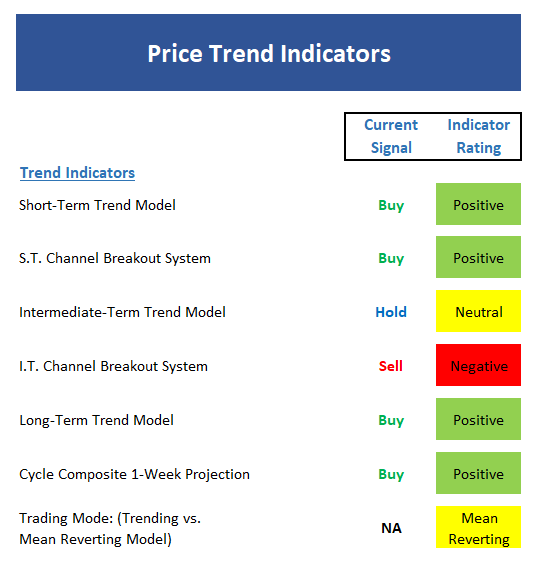
View Trend Indicator Board Online
Executive Summary:
- Although it was a sloppy week, all's well that ends well. The short-term Trend Model remains positive.
- The traditional approach to the short-term Channel Breakout system remains negative to start the week. However, given that stocks are in a mean-reverting environment, I prefer a modified approach that triggered a buy signal on 2/13. Thus, I will begin publishing the reading of this approach in our weekly review going forward.
- While it is pretty tough to accomplish, the intermediate-term Trend Model is neutral for a second week in a row.
- The intermediate-term Channel Breakout System remains on its 2/5 sell signal and is currently a very long way from a buy signal.
- The long-term Trend Model remains positive. And I am going to re-repeat what I've said here again: This is an indication that what we are experiencing is a correction and not a bear market.
- The Cycle Composite turns remains green this week, albeit only modestly so. The cycles suggest a very choppy uptrend into mid-March.
- From an intermediate-term perspective, the market remains in a mean-reverting mode.
- In sum, the trend has improved but the bulls aren't out of the woods yet.
The State of Internal Momentum
Next up are the momentum indicators, which are designed to tell us whether there is any "oomph" behind the current trend.
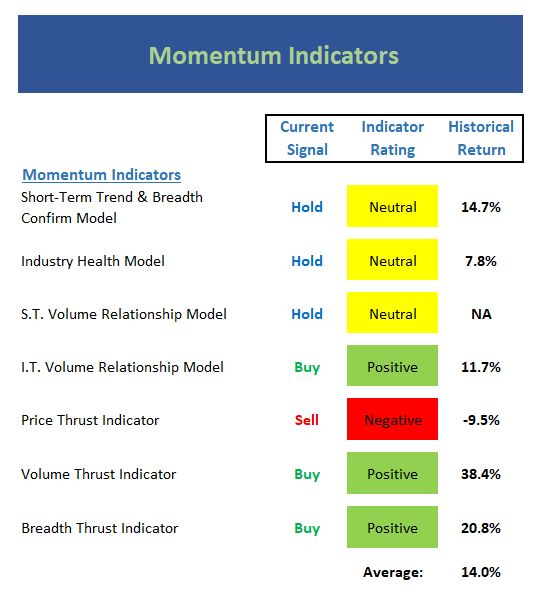
View Momentum Indicator Board Online
Executive Summary:
- The short-term Trend and Breadth Confirm Model remains neutral this week.
- The Industry Health Model remains in the neutral zone. However, it is important to note that this model has NOT flashed a sell signal. As such, longer-term investors should continue to side with the bulls.
- While up-volume has improved and is trending higher, the short-term Volume Relationship model flipped back to neutral last week.
- The intermediate-term Volume Relationship Model also tells us that the bulls should be given the benefit of any doubt.
- The intermediate-term Price Thrust Indicator can't seem to get out of the red zone. From a short-term view, this remains a concern and suggests that the corrective phase is ongoing.
- The good news is the Volume Thrust Indicator improved to positive last week. The bad news is the indicator has yet to flash a fresh buy signal.
- The Breadth Thrust Indicator also improved last week and produce a new buy signal - the first since early 2017. Note that the buy signal reversed the 2/5 sell for this indicator.
- The bottom line is market momentum continues to improve. And we are starting to see some buy signals. But it is important to remember that the best advances are accompanied by very strong breadth thrust signals.
The State of the "Trade"
We also focus each week on the "early warning" board, which is designed to indicate when traders might start to "go the other way" -- for a trade.

View Early Warning Indicator Board Online
Executive Summary:
- From a near-term perspective, stocks are quickly moving toward an overbought condition.
- From an intermediate-term view, stocks are closer to oversold than overbought.
- The Mean Reversion Model remains on its 2/14 buy signal. However, as you might expect from a mean-reversion model, the reading of the model is already starting to "go the other way."
- The short-term VIX indicator is starting to set up for the next sell signal. However, it is important to note that the VIX may be in a transition mode to a new range. As such, these signals need to be taken in context.
- Ditto from last week: The intermediate-term VIX signal remains on a buy signal as the indicator works off the extreme volatility signal produced at the beginning of the decline.
- From a short-term perspective, market sentiment reached the extreme pessimism zone and has now reversed to neutral. As such, the recent buy signal is still "on" but growing stale.
- After a very brief stint in the neutral zone, the intermediate-term Sentiment Model is back in the red zone to start the week.
- Same story for the Long-Term Sentiment Model. After briefly moving into the neutral zone last week, the model has slipped back into the red zone.
The State of the Macro Picture
Now let's move on to the market's "external factors" - the indicators designed to tell us the state of the big-picture market drivers including monetary conditions, the economy, inflation, and valuations.
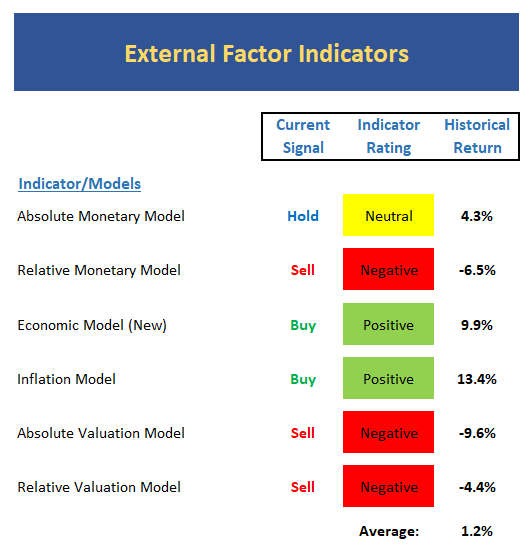
View External Factors Indicator Board Online
Executive Summary:
- The Absolute Monetary model remains neutral but is very close to a sell signal. I believe this is a good summary of the monetary environment. The bond market is either due for a big bounce or embarking on a new bear. Stay tuned here.
- The Relative Monetary Model remains in negative territory and on a sell signal.
- No change on the economic front. The Economic Model continues to suggest a strong economic environment and decent equity returns.
- The Inflation Model remains positive. But although the model has turned, it is a long way from signaling high inflationary pressures. Bottom line is this is a model I continue to watch very closely.
- The Absolute Valuation Model is negative and the reading is at the worst levels since the crisis ended.
- Our Relative Valuation Model (which incorporates the current level of interest rates) remains on the sell signal flashed at the beginning of the month.
- While historical returns must be taken with a grain of salt, the average return for the current readings is weak and well below the historical mean. As such, this tells us that risk factors remain elevated.
Sample Tactical Allocation Model
Below is an EXAMPLE (and ONLY an EXAMPLE) of how one might incorporate the indicator boards. The approach shown below is designed to provide the current equity allocation for a balanced tactical asset allocation model with a base target of 60/40 stocks/bonds.
The overall intent of the model is to keep equity exposure in line with current conditions.
Beginning February 2018, the model will be updated monthly.
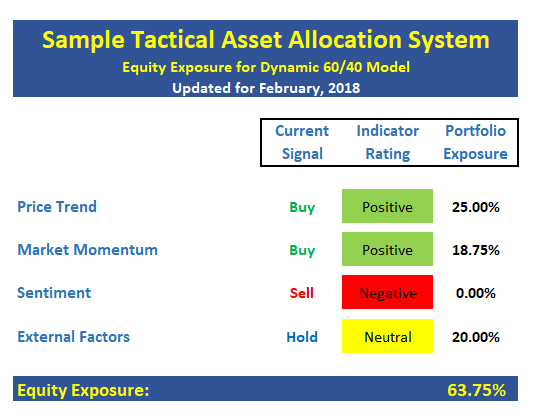
The model above is for illustrative and informational purposes only and does not in any way represent any investment recommendation. The model is merely a sample of how indicators can be grouped to create a guide to market exposure based on the inputs from multiple indicators/models.
Indicators Explained
Short-Term Trend-and-Breadth Signal Explained: History shows the most reliable market moves tend to occur when the breadth indices are in gear with the major market averages. When the breadth measures diverge, investors should take note that a trend reversal may be at hand. This indicator incorporates NDR's All-Cap Dollar Weighted Equity Series and A/D Line. From 1998, when the A/D line is above its 5-day smoothing and the All-Cap Equal Weighted Equity Series is above its 25-day smoothing, the equity index has gained at a rate of +32.5% per year. When one of the indicators is above its smoothing, the equity index has gained at a rate of +13.3% per year. And when both are below, the equity index has lost +23.6% per year.
Channel Breakout System Explained: The short-term and intermediate-term Channel Breakout Systems are modified versions of the Donchian Channel indicator. According to Wikipedia, "The Donchian channel is an indicator used in market trading developed by Richard Donchian. It is formed by taking the highest high and the lowest low of the last n periods. The area between the high and the low is the channel for the period chosen."
Intermediate-Term Trend-and-Breadth Signal Explained: This indicator incorporates NDR's All-Cap Dollar Weighted Equity Series and A/D Line. From 1998, when the A/D line is above its 45-day smoothing and the All-Cap Equal Weighted Equity Series is above its 45-day smoothing, the equity index has gained at a rate of +17.6% per year. When one of the indicators is above its smoothing, the equity index has gained at a rate of +6.5% per year. And when both are below, the equity index has lost -1.3% per year.
Industry Health Model Explained: Designed to provide a reading on the technical health of the overall market, Big Mo Tape takes the technical temperature of more than 100 industry sectors each week. Looking back to early 1980, when the model is rated as "positive," the S&P has averaged returns in excess of 23% per year. When the model carries a "neutral" reading, the S&P has returned over 11% per year. But when the model is rated "negative," stocks fall by more than -13% a year on average.
Cycle Composite Projections: The cycle composite combines the 1-year Seasonal, 4-year Presidential, and 10-year Decennial cycles. The indicator reading shown uses the cycle projection for the upcoming week.
Trading Mode Indicator: This indicator attempts to identify whether the current trading environment is "trending" or "mean reverting." The indicator takes the composite reading of the Efficiency Ratio, the Average Correlation Coefficient, and Trend Strength models.
Volume Relationship Models: These models review the relationship between "supply" and "demand" volume over the short- and intermediate-term time frames.
Price Thrust Model Explained: This indicator measures the 3-day rate of change of the Value Line Composite relative to the standard deviation of the 30-day average. When the Value Line's 3-day rate of change have moved above 0.5 standard deviation of the 30-day average ROC, a "thrust" occurs and since 2000, the Value Line Composite has gained ground at a rate of +20.6% per year. When the indicator is below 0.5 standard deviation of the 30-day, the Value Line has lost ground at a rate of -10.0% per year. And when neutral, the Value Line has gained at a rate of +5.9% per year.
Volume Thrust Model Explained: This indicator uses NASDAQ volume data to indicate bullish and bearish conditions for the NASDAQ Composite Index. The indicator plots the ratio of the 10-day total of NASDAQ daily advancing volume (i.e., the total volume traded in stocks which rose in price each day) to the 10-day total of daily declining volume (volume traded in stocks which fell each day). This ratio indicates when advancing stocks are attracting the majority of the volume (readings above 1.0) and when declining stocks are seeing the heaviest trading (readings below 1.0). This indicator thus supports the case that a rising market supported by heavier volume in the advancing issues tends to be the most bullish condition, while a declining market with downside volume dominating confirms bearish conditions. When in a positive mode, the NASDAQ Composite has gained at a rate of +38.3% per year, When neutral, the NASDAQ has gained at a rate of +13.3% per year. And when negative, the NASDAQ has lost at a rate of -8.5% per year.
Breadth Thrust Model Explained: This indicator uses the number of NASDAQ-listed stocks advancing and declining to indicate bullish or bearish breadth conditions for the NASDAQ Composite. The indicator plots the ratio of the 10-day total of the number of stocks rising on the NASDAQ each day to the 10-day total of the number of stocks declining each day. Using 10-day totals smooths the random daily fluctuations and gives indications on an intermediate-term basis. As expected, the NASDAQ Composite performs much better when the 10-day A/D ratio is high (strong breadth) and worse when the indicator is in its lower mode (weak breadth). The most bullish conditions for the NASDAQ when the 10-day A/D indicator is not only high, but has recently posted an extreme high reading and thus indicated a thrust of upside momentum. Bearish conditions are confirmed when the indicator is low and has recently signaled a downside breadth thrust. In positive mode, the NASDAQ has gained at a rate of +22.1% per year since 1981. In a neutral mode, the NASDAQ has gained at a rate of +14.5% per year. And when in a negative mode, the NASDAQ has lost at a rate of -6.4% per year.
Short-Term Overbought/sold Indicator: This indicator is the current reading of the 14,1,3 stochastic oscillator. When the oscillator is above 80 and the %K is above the %D, the indicator gives an overbought reading. Conversely, when the oscillator is below 20 and %K is below its %D, the indicator is oversold.
Intermediate-Term Overbought/sold Indicator: This indicator is a 40-day RSI reading. When above 57.5, the indicator is considered overbought and when below 45 it is oversold.
Mean Reversion Model: This is a diffusion model consisting of five indicators that can produce buy and sell signals based on overbought/sold conditions.
VIX Indicator: This indicator looks at the current reading of the VIX relative to standard deviation bands. When the indicator reaches an extreme reading in either direction, it is an indication that a market trend could reverse in the near-term.
Short-Term Sentiment Indicator: This is a model-of-models composed of 18 independent sentiment indicators designed to indicate when market sentiment has reached an extreme from a short-term perspective. Historical analysis indicates that the stock market's best gains come after an environment has become extremely negative from a sentiment standpoint. Conversely, when sentiment becomes extremely positive, market returns have been subpar.
Intermediate-Term Sentiment Indicator: This is a model-of-models composed of 7 independent sentiment indicators designed to indicate when market sentiment has reached an extreme from an intermediate-term perspective. Historical analysis indicates that the stock market's best gains come after an environment has become extremely negative from a sentiment standpoint. Conversely, when sentiment becomes extremely positive, market returns have been subpar.
Long-Term Sentiment Indicator: This is a model-of-models composed of 6 independent sentiment indicators designed to indicate when market sentiment has reached an extreme from a long-term perspective. Historical analysis indicates that the stock market's best gains come after an environment has become extremely negative from a sentiment standpoint. Conversely, when sentiment becomes extremely positive, market returns have been subpar.
Absolute Monetary Model Explained: The popular cliché, "Don't fight the Fed" is really a testament to the profound impact that interest rates and Fed policy have on the market. It is a proven fact that monetary conditions are one of the most powerful influences on the direction of stock prices. The Absolute Monetary Model looks at the current level of interest rates relative to historical levels and Fed policy.
Relative Monetary Model Explained: The "relative" monetary model looks at monetary indicators relative to recent levels as well as rates of change and Fed Policy.
Economic Model Explained: During the middle of bull and bear markets, understanding the overall health of the economy and how it impacts the stock market is one of the few truly logical aspects of the stock market. When our Economic model sports a "positive" reading, history (beginning in 1965) shows that stocks enjoy returns in excess of 21% per year. Yet, when the model's reading falls into the "negative" zone, the S&P has lost nearly -25% per year. However, it is vital to understand that there are times when good economic news is actually bad for stocks and vice versa. Thus, the Economic model can help investors stay in tune with where we are in the overall economic cycle.
Inflation Model Explained: They say that "the tape tells all." However, one of the best "big picture" indicators of what the market is expected to do next is inflation. Simply put, since 1962, when the model indicates that inflationary pressures are strong, stocks have lost ground. Yet, when inflationary pressures are low, the S&P 500 has gained ground at a rate in excess of 13%. The bottom line is inflation is one of the primary drivers of stock market returns.
Valuation Model Explained: If you want to get analysts really riled up, you need only to begin a discussion of market valuation. While the question of whether stocks are overvalued or undervalued appears to be a simple one, the subject is extremely complex. To simplify the subject dramatically, investors must first determine if they should focus on relative valuation (which include the current level of interest rates) or absolute valuation measures (the more traditional readings of Price/Earnings, Price/Dividend, and Price/Book Value). We believe that it is important to recognize that environments change. And as such, the market's focus and corresponding view of valuations are likely to change as well. Thus, we depend on our Valuation Models to help us keep our eye on the ball.
Disclosures
The opinions and forecasts expressed herein are those of Mr. David Moenning and may not actually come to pass. Mr. Moenning's opinions and viewpoints regarding the future of the markets should not be construed as recommendations. The analysis and information in this report is for informational purposes only. No part of the material presented in this report is intended as an investment recommendation or investment advice. Neither the information nor any opinion expressed constitutes a solicitation to purchase or sell securities or any investment program.
Any investment decisions must in all cases be made by the reader or by his or her investment adviser. Do NOT ever purchase any security without doing sufficient research. There is no guarantee that the investment objectives outlined will actually come to pass. All opinions expressed herein are subject to change without notice. Neither the editor, employees, nor any of their affiliates shall have any liability for any loss sustained by anyone who has relied on the information provided.
Mr. Moenning may at times have positions in the securities referred to and may make purchases or sales of these securities while publications are in circulation. Positions may change at any time.
The analysis provided is based on both technical and fundamental research and is provided "as is" without warranty of any kind, either expressed or implied. Although the information contained is derived from sources which are believed to be reliable, they cannot be guaranteed.
Investments in equities carry an inherent element of risk including the potential for significant loss of principal. Past performance is not an indication of future results.
